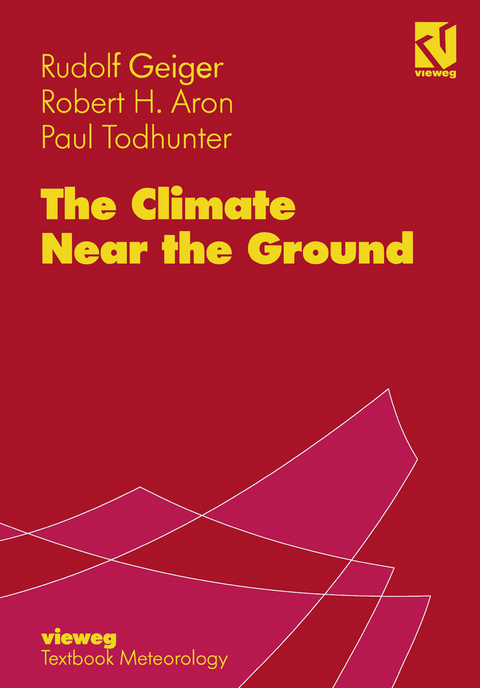
The Climate Near the Ground
Vieweg & Teubner (Verlag)
978-3-322-86584-7 (ISBN)
Die Bearbeiter: Prof. Aron lehrt Geographie und Klimatologie an der Universität Mount Pleasant, Michigan, USA; Dr. Todhunter ist Klimatologe an der Universität von Grand Forks, North Dakota, USA.
1. Microclimate and Research.- I. Earth's Surface Energy Balance.- 2. Physical Basis of the Earth's Radiation Balance.- 3. Components of the Energy Balance and Their Importance.- 4. Radiation Balance of the Earth's Surface.- 5. Longwave Radiation at Night.- 6. The Laws of Energy Transport in the Ground.- 7. Transport of Energy in the Atmosphere. Eddy Diffusion.- 8. Mixing Due to Friction and Convection.- 9. Temperature Instability, Dissemination of Seeds, Dispersion of Air Pollutants, and Effective Stack Height as Problems of Eddy Diffusion.- II. The Air Layer over Level Ground without Vegetation.- 10. Normal Temperature Stratification in the Underlying Surface (the Ground).- 11. Temperature in the Lowest 100 m of the Atmosphere.- 12. The Unstable Sublayer and the Inversion Sublayer.- 13. Daytime Temperature of the Air Layer near the Ground.- 14. Nighttime Temperature of the Air Layer near the Ground.- 15. Distribution of Water Vapor above the Ground.- 16. The Wind Field and the Influence of Wind near the Ground.- 17. Distribution of Particulates and Trace Gases.- 18. Optical Phenomena Occurring near the Ground.- III. Influence of the Underlying Surface on the Adjacent Air Layer.- 19. Soil Type, Soil Mixtures, Soil Tillage.- 20. Ground Color, Surface Temperature, Ground Cover (Mulching) and Greenhouses.- 21. Soil Moisture and Ground Frost.- 22. The Air Layer above Small Water Surfaces.- 23. The Air Layer near the Water Surface of Lakes, Seas and Rivers.- 24. The Air Layer near Snow and Ice.- IV. Further Analysis of the Energy Balance.- 25. Basis and Methods of Evaluation.- 26. Results of Previous Energy Balance Measurements.- 27. Advective Influences and Transitional Climates.- 28. Remarks on Evaporation.- V. The Effect of Low Plant Cover on the Surface AirLayer.- 29. Energy Balance and Temperature of Plant Components.- 30. Radiation, Eddy Diffusion, and Evaporation in a Low Plant Cover.- 31. The Microclimate of Meadows and Grain Fields.- 32. The Microclimate of Gardens, Potato Fields, and Vineyards.- VI. Forest Climatology.- 33. Radiation in a Forest.- 34. Metabolism, Energy Storage and Wind in a Forest.- 35. Air Temperature and Humidity in a Forest.- 36. Dew, Rain, and Snow in a Forest.- 37. Microclimate at the Stand Edges.- 38. Further Problems Concerning the Local Climate of Forests.- 39. Climatic Influences of the Forest.- VII. The Influence of Topography on the Microclimate.- 40. Insolation on Various Slopes.- 41. The Effect of Differing Amounts of Sunshine on Microenvironment.- 42. Small-Scale Topographic Influences at Night (Cold Air Currents, Frost Hollows).- 43. Local Winds in Hilly and Mountainous Terrain.- 44. The Climate of Various Slopes (Exposure Climate).- 45. The Thermal Belt.- 46. Microclimate in the High Mountains.- 47. The Microclimate of Caves.- VIII. Interrelation of Animals and Humans to the Microclimate.- 48. Animal Behavior.- 49. Animal Dwellings.- 50. Bioclimatology.- 51. Urban Climate.- 52. Artificial Protection against Wind.- 53. Artificial Protection against Low Temperatures.- References.- Symbols.- Conversion Table.- Author Index.
| Erscheint lt. Verlag | 12.2.2012 |
|---|---|
| Zusatzinfo | XVI, 528 p. |
| Verlagsort | Wiesbaden |
| Sprache | englisch |
| Maße | 170 x 244 mm |
| Gewicht | 933 g |
| Themenwelt | Technik |
| Schlagworte | Atmosphere • Climate • climatology • Design • DEW • Energy • Environment • Environmental Science • Frost • Radiation • scale • Snow • Temperature • Vegetation • Wind |
| ISBN-10 | 3-322-86584-3 / 3322865843 |
| ISBN-13 | 978-3-322-86584-7 / 9783322865847 |
| Zustand | Neuware |
| Haben Sie eine Frage zum Produkt? |
aus dem Bereich


